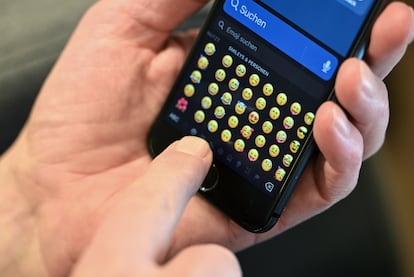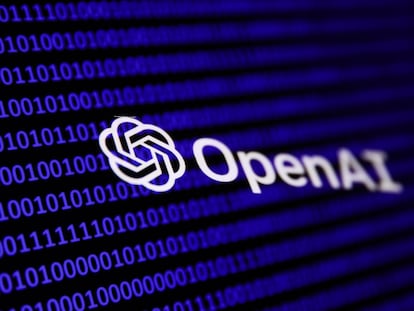Emojis are not a universal language: Gender, age and culture influence their interpretation
A recent study states that a person’s background can completely change their understanding of these symbols


Emojis are part of our daily lives. Chats, posts and social media comments are almost always punctuated with little yellow smileys, animals, hearts, flames and much more, depending on the emotion that we want to convey. These small, brightly colored symbols are so common that some people even take their absence as a sign that the other person is being rude... or perhaps they are angry. However, not everyone reads those digital hieroglyphs equally. Researchers from the University of Nottingham say that age, gender and culture can influence the way we interpret them.
The study, published in February in the journal Plos One, had 523 participants from China and the UK, ranging from 18 to 84 years old. The authors used six emojis from four different platforms (Apple, Android, Windows and WeChat) that represented six emotions: happiness, disgust, fear, sadness, surprise and anger. The article explains that women are slightly more accurate in recognizing happy, fearful, sad and angry emojis. Lead author Ruth Filik believes it is a matter of interpretation rather than accuracy. In this case, the female participants labeled the emojis the same way as the researchers more often than the men, she notes.
As for the faces representing surprise and disgust, there were no differences in perception between women and men. In fact, disgust was the only emotion in which no differences were seen by age, gender or culture when identifying the face that represented it. Xandra Garzón, who specializes in the figure of women in the digital world, suggests that there could be a greater tendency to show only positive emotions, which would push the symbols of negative emotions to a less frequent use. Thus, a lesser used emoji could be more difficult to identify or interpret.
Regarding age, there is an “accuracy advantage for younger participants,” explains the text. One of the factors taken into account is how familiar they were with each symbol. This lack of habit may explain the differences in results between older and younger people, says Filik. For Garzón, a clear example of generational differences can be found in family WhatsApp groups: “The use is completely different, to the point that it often escapes us older people.”
Culture is the aspect that makes the biggest difference, with the British participants being more accurate in associating the faces with the right emotion than the Chinese. The authors point out that the explanation may have to do with the way these symbols are used, as Chinese respondents tend to represent these emotions with completely different emojis: for instance, they use happy faces with negative connotations, such as sarcasm.
Agnese Sampietro, a professor and researcher at the Jaume I University (Spain), points out that it is difficult to find any functions of emojis that might be considered universal, and that the way these symbols are presented to respondents matters. Without any context, it is normal to obtain different interpretations explains the linguist, who has several studies on the subject, but some context can help. Sampietro also emphasizes that the differences in identifying emojis are not necessarily a sign of misunderstandings or obstacles in communication.

Cristina Vela, vice dean of the University of Valladolid (Spain) and author of Los emojis en la interacción digital escrita (Emojis in written digital interaction), explains that these symbols obtain their meaning through the use they are given. “You interpret them as you use them, and that takes place in a speech community that is marked by a certain culture.”
Vela highlights that studies such as the one from the University of Nottingham shed some light on interesting aspects of the contemporary way of communicating, and can help improve it. Research in the virtual sphere is increasingly relevant because a large part of our lives takes place in these virtual environments, says Garzón. “The internet is where we relax, where we work, where we do absolutely everything.”
Communication evolves
Emojis help to understand what the person that sent the message really wants to express and add “a touch of color,” points out Sampietro. “It allows you to personalize a conversation that could be too flat with the default format of social media.” Garzón adds that they make communication simpler and more fluid, “even more effective.” Still, not everyone uses them with this in mind, says Vela; some just use them because “it looks pretty.”
Their interpretation and use depend on who you are writing to. People are not going to use the same emojis in a work chat than in a conversation with family or friends, as they are different kinds of relationships, says Sampietro; one is closer than the other. In addition, Garzón points out, their communicative function is also different: “The way I feel about something will probably not be very interesting in the work group, and certain emojis make no sense there.”
Both the symbols and their interpretation have changed over time. These tiny pictograms have been increasing in complexity and diversity: in 2015, emojis representing body parts or people performing actions began to be available in different skin tones. That same year, same-sex couples were also included. Garzón points out that these details are not at all banal; it is a matter of identity. “These types of digital representations are absolutely fundamental.”
These symbols have become part of people’s identity in such a way that we could even identify some people in a chat solely by the emojis they use, states Garzón. Emojis may facilitate communication, but it is us who give them a meaning, she concludes.
Sign up for our weekly newsletter to get more English-language news coverage from EL PAÍS USA Edition
Tu suscripción se está usando en otro dispositivo
¿Quieres añadir otro usuario a tu suscripción?
Si continúas leyendo en este dispositivo, no se podrá leer en el otro.
FlechaTu suscripción se está usando en otro dispositivo y solo puedes acceder a EL PAÍS desde un dispositivo a la vez.
Si quieres compartir tu cuenta, cambia tu suscripción a la modalidad Premium, así podrás añadir otro usuario. Cada uno accederá con su propia cuenta de email, lo que os permitirá personalizar vuestra experiencia en EL PAÍS.
¿Tienes una suscripción de empresa? Accede aquí para contratar más cuentas.
En el caso de no saber quién está usando tu cuenta, te recomendamos cambiar tu contraseña aquí.
Si decides continuar compartiendo tu cuenta, este mensaje se mostrará en tu dispositivo y en el de la otra persona que está usando tu cuenta de forma indefinida, afectando a tu experiencia de lectura. Puedes consultar aquí los términos y condiciones de la suscripción digital.
More information
Archived In
Últimas noticias
ICE raids trigger school absenteeism and traumatize children: ‘They have been forced to leave their childhood behind’
The guardians of the meteorites of the Argentine Chaco
Helen Levitt, the photographer who captured the theater of the everyday
The life of a delivery driver in China: ‘Many people don’t know how an order can arrive at their home in just one day’
Most viewed
- Christian Louboutin: ‘Young people don’t want to be like their parents. And if their parents wear sneakers, they’re going to look for something else’
- US sanctions against jailed cartel leader ‘El Marro’ highlight Mexico’s lack of control over its prisons
- The low-cost creative revolution: How technology is making art accessible to everyone
- Liset Menéndez de la Prida, neuroscientist: ‘It’s not normal to constantly seek pleasure; it’s important to be bored, to be calm’
- Cartels in Mexico take a leap forward with narco-drones: ‘It is criminal groups that are leading the innovation race’










































